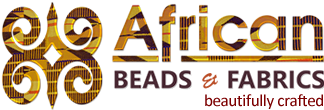Introduction
Adinkra symbols form part of the socio-cultural and economic lives of the Akan people where they have unique meanings. They are at various times, are used to transmit messages, offer advice and serve a lot more purposes on different occasions. Thus, they bear wider socio-cultural, economic and spiritual significance.
They will be found on other Akan artifacts like stools, chieftaincy paraphernalia and emblems of various purposes. Their use is now more widespread.
Kwaku Nsia, Pinkyehen and Kwadwo Appiah are the three men believed to have been the first to print the Adinkra fabric in Ashanti. They first made their dyes in smaller containers and used cocoyam and cassava (both starchy root crops) stamps. A man called Kwadwo Anane introduced carved calabash (made from dried out wild-growing gourd) Adinkra stamps and this has since worked well.
- various adinkra symbols made from calabash stamps
- adinkra stamps displayed on work bench
The first Adinkra printers created many of the designs which survived several generations till today with some modified whilst others remain unaltered. New designs have been introduced over the years and the current generation of weavers continue to introduce new ones.
Symbolism/Significance
The Adinkra symbols express various themes that relate to the history, beliefs and philosophy of the Asantes. They mostly have rich proverbial meanings since proverbs play an important role in the Asante culture. The use of proverbs is considered as a mark of wisdom. Other Adinkra symbols depict historical events, human behaviour and attitudes, animal behaviour, plant life forms and shapes of objects. In fact, the Adinkra symbols continue to change as new influences impact on Ghanaian culture as some of the symbols now record specific technological developments.
Being originally associated with funerals, Adinkra symbolism often represents thoughts that cannot be expressed simply. In Akan tradition, speaking in proverbs is highly valued. Many Adinkra symbols have proverbs attached to them. For those schooled in the complex art of Akan proverb usage these sayings represent thoughts that have been preserved through time and represent a whole literary form combining brevity, precision and depth of thought.
The first Adinkra printers created many of the designs which survived several generations till today with some modified whilst others remain unaltered. New designs have been introduced over the years and the current generation of weavers continue to introduce new ones.
Among the first five Adinkra symbols created were “Adinkrahene”, “Sankofa”, “Gye Nyame”, “Funtumfunafu Denkyemfunafu” and “Nyame Dua”.
- adinkrahene
- gye Nyame
- Funtumfunafu denkyemfunafu
- “Adinkrahene” (King or Chief of all Adinkra)
- “Sankofa” (A return to basics)
- “Gye Nyame” (Except God)
- “Funtumfunafu denkyemfunafu” (sharing one stomach, yet they fight over food)
- “Nyame dua” (Gods Tree – an altar to the sky God).
In modern day usage Adinkra symbols have a largely decorative function. They can be seen decorating buildings, vehicles and books and more. They are represented in the logos of many public and private organisations. Many fabrics have Adinkra symbols incorporated into their designs as are other decorative items of personal use such as pendants, key rings, wallets etc.
Below is a table that displays some of the old and new Adinkra and other cultural symbols of the Akan. They have been arranged by names in Twi, literal translation in English, significance and proverbial meanings where available. The information in the table was obtained by reading some of the publications on the subject, speaking to Adinkra cloth makers in Ntonsu in the Ashanti Region of Ghana and other people with knowledge of the subject.
The Meaning of Adinkra Symbols
 |
GYE NYAME (Except God):A symbol of the supremacy of God This unique and beautiful symbol is ubiquitous in Ghana. It is by far the most popular for use in decoration, a reflection on the deeply religious character of the Ghanaian people. |
  |
SANKOFA (return and retrieve, go back and take it)This symbol reminds us of importance of learning from our past successes and failures. Only a fool fails to learn the lessons from the past, making the same mistake time and again There are two versions of this symbol. One is a bird looking backwards (often with an egg in its mouth) and the other is the silhouette of two birds facing each other. |
 |
ADINKRAHENE (Chief of the adinkra symbols)symbol of greatness, charisma and leadership This symbol is said to have played an inspiring role in the designing of other symbols. It signifies the importance of playing a leadership role. |
 |
FUNTUNFUNEFU-DENKYEMFUNEFU (Siamese crocodiles)Symbol of democracy and unity. This symbol consists of two reptiles at right angles to each other and sharing a central region representing the stomach “Siamese crocodiles share one stomach, yet they fight over food”. This popular symbol is a reminder that infighting and divisions is harmful to all who engage in it. |
 |
DENKYEM (Crocodile)Symbol of adaptability The crocodile lives in the water, yet breathes the air, demonstrating an ability to adapt to circumstances. |
 |
DWENNIMMEN (Ram’s horns)Symbol of humility together with strength The ram will fight fiercely against an adversary, but it also submits humbly to slaughter, emphasising that even the strong need to be humble. This symbol is my favourite and is used in the design of the logo for this website. |
 |
AKOMA NTOSO (Linked hearts)Symbol of understanding and agreement |
 |
NYAME NTI (Because of God, by God’s grace)Symbol of faith and trust in God similar to Gye Nyame According to The Adinkra Dictionary by W. Bruce Willis: “This stalk is depicted as the staff of life in many cultures. It symbolizes to the Akan that food is a basis of life and that they could not survive if not for the food that God has placed here on Earth for their nourishment. “ |
 |
NYAME BIRIBI WO SORO (God is in the heavens)Symbol of hope A reminder that God’s dwelling place is in the heaven, where he can listen to all prayers. |
 |
NKYINKYIM (Twisting)Symbol of initiative, dynamism and versatility The proverb linked to this symbol is translated as “Life’s journey is twisted”, Life’s journey is not smooth, one need to to be resilient and resourceful to get through it. |
 |
NSOROMMA (Star, child of the heavens)Symbol of guardianship A reminder that God is the father and watches over His people as the stars watch over us at night |
 |
BI NKA BI (One should not bite the other person, do not bite one another)A symbol of peace and harmony, it encourages us to live at peace with our fellow human beings This symbol cautions against provocation and strife. The image is based on two fish biting each others’ tails. |
 |
AKOKO NAN (Leg of a hen)Symbol of nurturing and discipline The full name of this symbol translates to “The hen treads on her chicks, but she does not kill them.” This represents the ideal nature of parents, being both protective and corrective. An exhortation to nurture children, but a warning not to pamper them. |
 |
FIHANKRA (House or compound, compound house)Symbol of security and safety Typical of Akan (Asante) architecture, the communal housing compound has only one entrance and exit. This symbol appears to show the plan of a typical compound house with dwellings on the four sides and a communal area in the middle for activities such as cooking and washing. People living on the compound would typically be related eg grown up children of an older couple with their spouses and children. Woe betide the burglar who chooses to visit this house at night. They will face not just one family but several and will be lucky to escape with minor injuries! |
 |
EBAN (Fence)Symbol of love, safety and security The home to the Akan is a special place. A home which has a fence around it is considered to be an ideal residence. The fence symbolically separates and secures the family from the outside. Because of the security and the protection that a fence affords, the symbol is also associated with the security and safety one finds in love. |
 |
AKOBEN (War horn)Symbol of vigilance and watchfulness Akoben is a horn used to sound a battle cry. The traditional Ashanti war horn is made of the tusk of an elephant. In ancient times, the horn was used as a call to battle and to frighten the enemy. In modern times it serves a ceremonial function during festivals and royal functions. |
 |
NKONSONKONSON (Chain link)Symbol of unity and human relations A reminder to contribute to the community, that in unity lies strength. |
 |
OWO FORO ADOBE (Snake climbing the raffia tree)Symbol of steadfastness, prudence and diligence Because of its thorns, the raffia tree is a very dangerous challenge to the snake. Its ability to climb it is a model of persistence and prudence. |
 |
AKOMA (Heart)Symbol of patience and tolerance. Throughout the world the heart is considered a symbol of patience. In the Akan dialects a person who is patient is said to “have their heart in their stomach” |
 |
HWE MU DUA (Measuring stick)Symbol of examination and quality control This symbol stresses the need to strive for the best quality, whether in production of goods or in human endeavours. The Ghana Standards Board, responsible for quality control incorporated this symbol in its logo. |
 |
HYE WON HYE (That which does not burn)Symbol of indestructibility and endurance This symbol gets its meaning from traditional priests that were able to walk on fire without burning their feet, an inspiration to others to endure and overcome difficulties. |
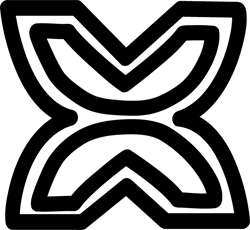 |
FAWOHODIE (Independence)Symbol of independence, freedom, emancipation “From the expression: Fawodhodie ene obre na enam. |
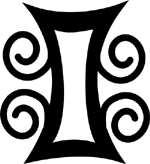 |
TAMFO BEBRE (The enemy will suffer)“the enemy will stew in his own juice” symbol of jealousy and envy |
 |
DUAFE (Wooden comb)Symbol of beauty and cleanliness; symbols of desirable feminine qualities The meaning of this symbol is characterised slightly differently in “The Adinkra Dictionary” and “The Values of Adinkra Symbols”; the former emphasises more abstract qualities of feminine goodness, love and care, while the latter has a more literal interpretation, looking one’s best and good hygiene. In any case, the duafe was a prized possession of the Akan woman, used to comb and plait her hair. |
 |
MMUSUYIDEE (Remover of misfortune)Symbol of good fortune and sanctity |
 |
OSRAM NE NSOROMMA (The moon and star)Symbol of love, faithfulness, harmony This symbol reflects the harmony that exists in the bonding between a man and a woman. Proverb: “Kyekye pe aware.” (The North Star has a deep love for marriage. She is always in the sky waiting for the return of the moon, her husband.) |
 |
KINTINKANTAN (Puffed up extravagance)Symbol of arrogance |
 |
BESE SAKA (Sack of cola nuts)Symbol of affluence, power, abundance, plenty, togetherness and unity The cola nut played an important role in the economic life of Ghana. A widely-used cash crop, it is closely associated with affluence and abundance. This symbol also represents the role of agriculture and trade in bringing peoples together. |
 |
ASASE YE DURU (The Earth has weight, the Earth is heavy)Symbol of providence and the divinity of Mother Earth (Asase Yaa) This symbol represents the importance of the Earth in sustaining life. |
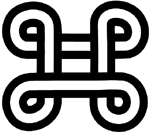 |
MPATAPO (Knot of reconciliation)Symbol of reconciliation, peacemaking and pacification Mpatapo represents the bond or knot that binds parties in a dispute to a peaceful, harmonious reconciliation. It is a symbol of peacemaking after strife. |
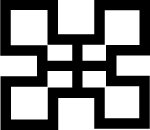 |
NSAA (Type of hand woven fabric)“a type of hand-woven fabric” symbol of excellence, genuineness, authenticity According to “The Adinkra Dictionary” by W. Bruce Willis, the nsaa symbols reflect a saying: “nea onnim nsaa oto n’ago”, which he translates as “He who does not know authentic Nsaa will buy the fakes.” The quality of Nsaa has come to represent quality of workmanship in general |
 |
NKYIMU (Crossed divisions made on adinkra cloth before stamping)Symbol of skilfulness, precision Before adinkra cloth is stamped with the symbols, the artisan blocks off the cloth with lines in a rectangular grid using a broad-tooth comb. This preparation is symbolic of the exacting technique which results in the highest quality product. |
 |
SESA WO SUBAN (Change your behaviour)“Change or transform your character ” symbol of life transformation This symbol combines two separate adinkra symbols, the “Morning Star” which can mean a new start to the day, placed inside the wheel, representing rotation or independent movement. |
 |
EPA (Handcuffs)Symbol of law and justice, slavery and captivity Adolph Agbo, in “Values of Adinkra Symbols” notes that handcuffs were introduced in Africa as a result of the slave trade, and later became popular among chiefs in cuffing offenders of the law. “The symbol reminds offenders of the uncompromising nature of the law. It however discourages all forms of slavery.” |
 |
DAME-DAME (Name of a board game)Symbol of intelligence and ingenuity |
 |
ESE NE TEKREMA (The teeth and the tongue)Symbol of friendship and interdependence The teeth and the tongue play interdependent roles in the mouth. They may come into conflict, but they need to work together. |
 |
NYAME NNWU NA MAWU (God never dies, therefore I cannot die)Symbol of God’s omnipresence and the perpetual existence of man’s spirit This signifies the immortality of man’s soul, believed to be a part of God. Because the soul rests with God after death, it cannot die |
 |
NYANSAPO (Knot of wisdom)Symbol of wisdom, ingenuity, intelligence and patience An especially revered symbol of the Akan, this symbol conveys the idea that “a wise person has the capacity to choose the best means to attain a goal. Being wise implies broad knowledge, learning and experience, and the ability to apply such faculties to practical ends.” |
 |
ODO NNYEW FIE KWAN (Love does not lose its way home)Symbol of the power of love |
 |
MATE MASIE (What I hear, I keep)Symbol of wisdom, knowledge and prudence The implied meaning of the phrase “mate masie” is “I understand”. Understanding means wisdom and knowledge, but it also represents the prudence of taking into consideration what another person has said. |
 |
FOFO (A plant with yellow flowers)Symbol of jealousy and envy “When the fofo’s petals drop, they turn into black spiky-like seeds. The Akan liken the nature of this plant to a jealous person.” There is a Akan proverb associated with this symbol: “What the fofo plant wishes is that the gyinantwi seeds turn black.” |
 |
OWUO ATWEDEE (Death’s ladder)Symbol of mortality a reminder of the transitory nature of existence in this world and of the imperative to live a good life to be a worthy soul in the afterlife |
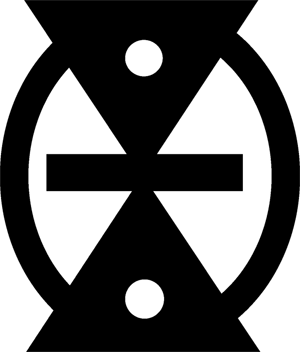 |
MMERE DANE (Times/ situations change, no situation is permanent)Symbol of change. Nobody’s situation remains the same for ever. This saying can be of comfort to a person going through a difficult time eg financial difficulty. They believe that in due course their situation will improve if they persevere. Time changes is a famous highlife song by Akwesi Ampofo Adjei addressing this issue. It is interesting to note the incorporation of the hourglass figure in this symbol, suggesting an European influence |
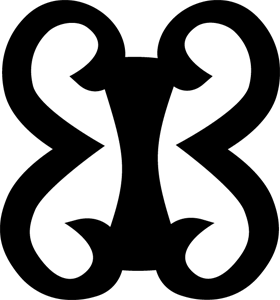 |
PEMPAMSIE (Sew in readiness, sew and put away)Symbol of readiness, steadfastness, hardiness According to the Adinkra Dictionary, the design of this symbol resembles the links of a chain, and implies strength through unity as well as the importance of being prepared. |
 |
NYAME DUA (God’s tree, altar)Symbol of God’s presence and protection The Nyame Dua is a sacred spot within the African Traditional Religion context where rituals are performed. Erected in front of the house or compound, it is crafted from a tree that has been cut where three or more branches come together. This stake holds an earthenware vessel filled with water and herbs or other symbolic materials for purification and blessing rituals. |
 |
AYA (Fern)“fern” symbol of endurance and resourcefulness The fern is a hardy plant that can grow in difficult places. “An individual who wears this symbol suggests that he has endured many adversities and outlasted much difficulty.” (Willis, The Adinkra Dictionary) |
 |
WAWA ABA (Seed of the wawa tree)Symbol of hardiness, toughness and perseverance The seed of the wawa tree is extremely hard. In Akan culture, it is a symbol of someone who is strong and tough. It inspires the individual to persevere through hardship. |
 |
NEA ONNIM NO SUA A, OHU (He who does not know can know from learning)Symbol of knowledge, life-long education and continued quest for knowledge. It encourages us to engage in life-long learning to enrich our lives and keep our brain active into old age. |
 |
ANANSE NTONTAN (Spider’s web)Symbol of wisdom, creativity and the complexities of life Ananse, the spider, is a well-known character in African folktales. Folklore has it that a spider’s web was the inspiration for Ashanti kente weaving. |
 |
MPUANNUM (Five tufts (of hair))Symbol of priestly office, loyalty and adroitness “This symbol is said to be the hairstyle of joy. It is the traditional hairstyle of the priestesses. … The design of the adinkra symbol mpuannum resembles the way the priestesses’ hair was tied. … It also represents the devotion and faithfulness one displays when doing a task required of one. In addition, mpuannum means loyalty or the embodiment of lofty duty to a desired goal.” |
 |
KWATAKYE ATIKO (Hair style of Kwatakye (an Ashanti war captain))Symbol of bravery and valour “This symbols is said to be a special hair style of Kwatakye, a war captain of old Asante. The symbol has come to represent bravery and fearlessness. It is also given as an earned title to any brave son of an Akan community.” |
 |
ONYANKOPON ADOM NTI BIRIBIARA BEYE YIE (By God’s grace, all will be well)A popular saying among Ghanaians and a symbol of hope, providence, faith |
 |
NYAME YE OHENE (God is king)Symbol of majesty and supremacy of God. This symbol includes the Gye Nyame symbol. |
 |
OKODEE MMOWERE (Eagle’s talons)Symbol of strength, bravery, power The eagle is the mightiest bird in the sky, and its strength is concentrated in its talons. The Oyoko clan, one of the nine Akan clans, uses this symbol as their clan emblem. |
 |
AKOFENA (Sword of war)Symbol of courage, valour, and heroism The crossed swords were a popular motif in the heraldic shields of many former Akan states. In addition to recognising courage and valour, the swords can represent legitimate state authority. This symbol is used in the logo of Databank, a private bank in Ghana. In modern times the Ashanti war sword has a largely decorative and ceremonial function |
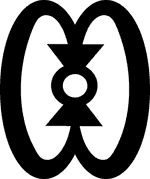 |
WO NSA DA MU A (“If your hand is in the dish”)Symbol of participatory government, democracy and pluralism From the aphorism, “Wo nsa da mu a, wonni nnya wo” – If your hands are in the dish, people do not eat everything and leave you nothing.” |
 |
BOA ME NA ME MMOA WO (“Help me and let me help you”)Symbol of cooperation and interdependence |
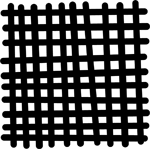 |
KETE PA (Good bed, good mat)Symbol of a good marriage From the expression that a woman who has a good marriage is said to sleep on a good bed. This symbol shows an interwoven pattern representing a traditional sleeping mat made of natural material such as raffia palm. At night the mat is laid on the floor for people to sleep on … definitely not as comfortable as sleeping on a mattress! |
 |
WOFORO DUA PA A (When you climb a good tree)Symbol of support, cooperation and encouragement From the expression “Woforo dua pa a, na yepia wo” meaning “When you climb a good tree, you are given a push”. More metaphorically, it means that when you work for a good cause, you will get support. |
 |
NEA OPE SE OBEDI HENE (He who wants to be king)Symbol of service and leadership From the expression “Nea ope se obedi hene daakye no, firi ase sue som ansa” meaning “He who wants to be king in the future must first learn to serve.” |
 |
MFRAMADAN (Wind resistant house)“wind-resistant house” symbol of fortitude and readiness to face life’s vicissitudes “This symbol suggests a reinforced or well-built home — one built to withstand windy and treacherous conditions. It reflects in Asante history a clause in the unwritten constitution of the Golden Stool. Oral accounts say that according to that clause, mud houses in Kumasi must be reinforced with turf. This reinforcing would cause the house to be sturdier and resistant to unfavorable weather conditions.” |
 |
ME WARE WO (I shall marry you)“I shall marry you ” symbol of commitment, perseverance From the expression “No one rushes into the job of mixing the concrete for building the house of marriage.” |
References
- Boakye Gabriel K. (2007). The Production of Adinkra Cloth. Kumasi: ED-Jay Services Ltd
- West African Wisdom: Adinkra Symbols & Meanings (2010) retrieved September 1, 2010 from http://www.adinkra.org/htmls/adinkra_bibliography.htm
- The Values of Adinkra Symbols: Adolph H Agbo
- Cloth as a Metaphor: GFK Arthur
- Adinkra Dictionary: W. Bruce Willis
- Angela Christian. Facets of Ghanaian Culture. pp 155-159
- Adolph Hilary Agbo. Values of Adinkra Symbols, Revised Edition
- Kofi Antobam. Adinkra, A Ghanaian Mourning Cloth. Ghana’s Heritage of Culture, 1963
- All stories regarding the history of Adinkra, contesting claims of time origin and production process are based on interviews with the Ntonso Craft Village and Visitor Centre.
